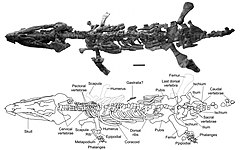Thalassophonea
| Thalassophoneans | |
|---|---|

| |
| Liopleurodon ferox | |

| |
| Sachicasaurus vitae | |
| Scientific classification | |
| Domain: | Eukaryota |
| Kingdom: | Animalia |
| Phylum: | Chordata |
| Class: | Reptilia |
| Superorder: | †Sauropterygia |
| Order: | †Plesiosauria |
| Family: | †Pliosauridae |
| Clade: | †Thalassophonea Benson & Druckenmiller, 2013 |
| Subgroups | |
Thalassophonea is an extinct clade of pliosaurids from the Middle Jurassic to the early Late Cretaceous (Callovian to Turonian) of Australia, Europe, North America and South America. Thalassophonea was erected by Roger Benson and Patrick Druckenmiller in 2013. The name is derived from Greek thalassa (θάλασσα), "sea", and phoneus (φονεύς), "murderer". It is a stem-based taxon defined as "all taxa more closely related to Pliosaurus brachydeirus than to Marmornectes candrewi".[1] It includes the short necked and large headed taxa that typify the family.[2][3] Some pliosaurids of Thalassophonea have been the largest predators in Mesozoic seas for more than 80 million years.[2]
Classification
The following cladogram follows an analysis by Benson & Druckenmiller (2014).[1]







